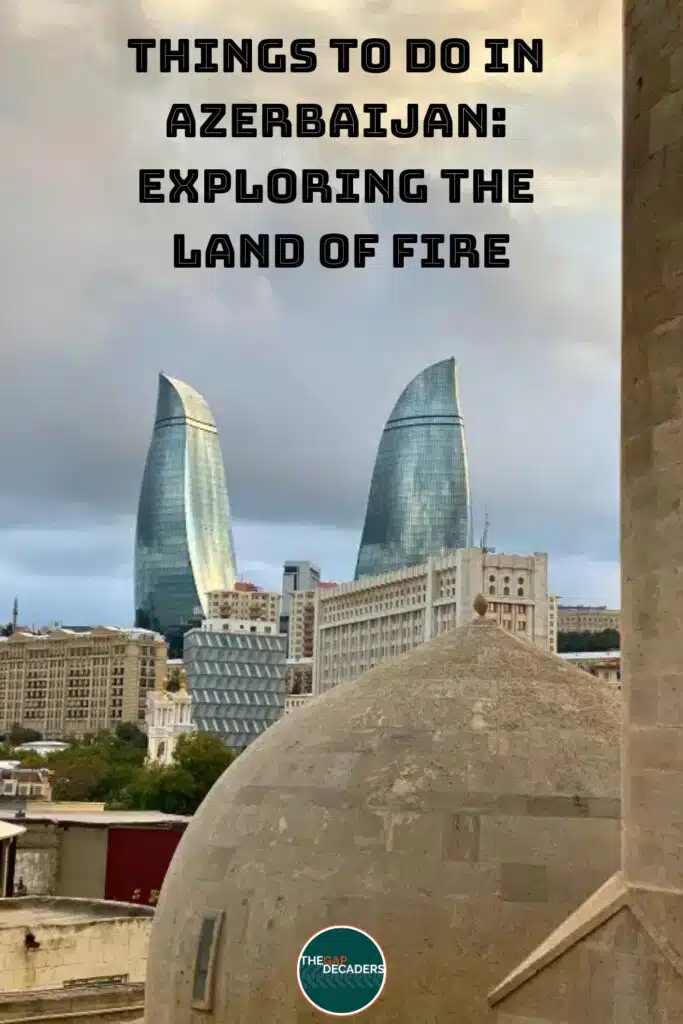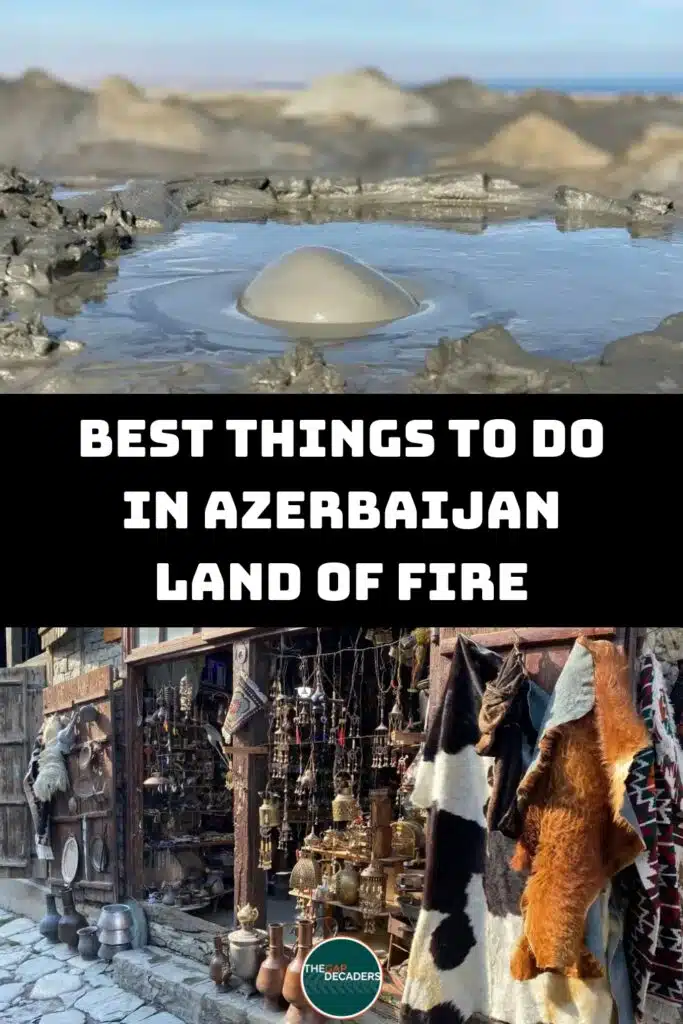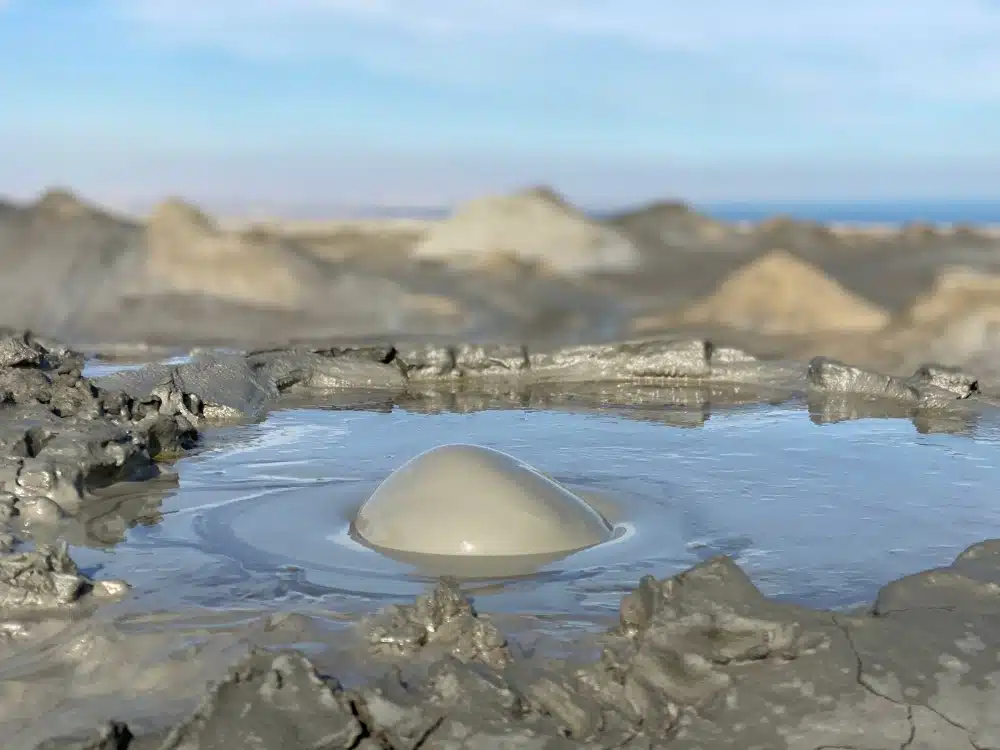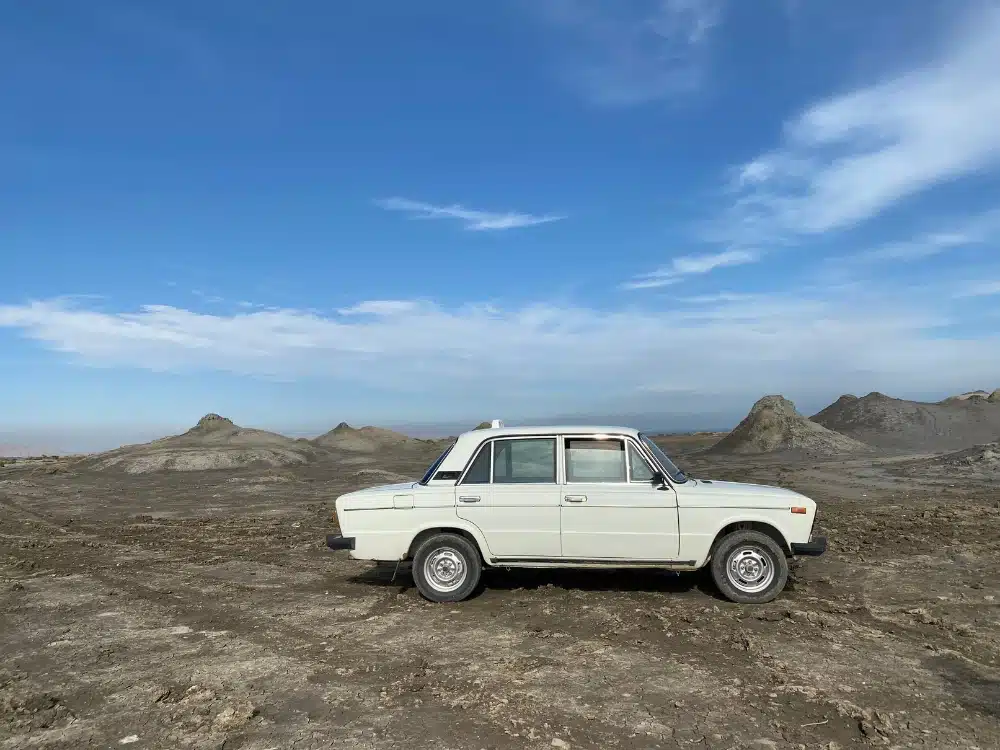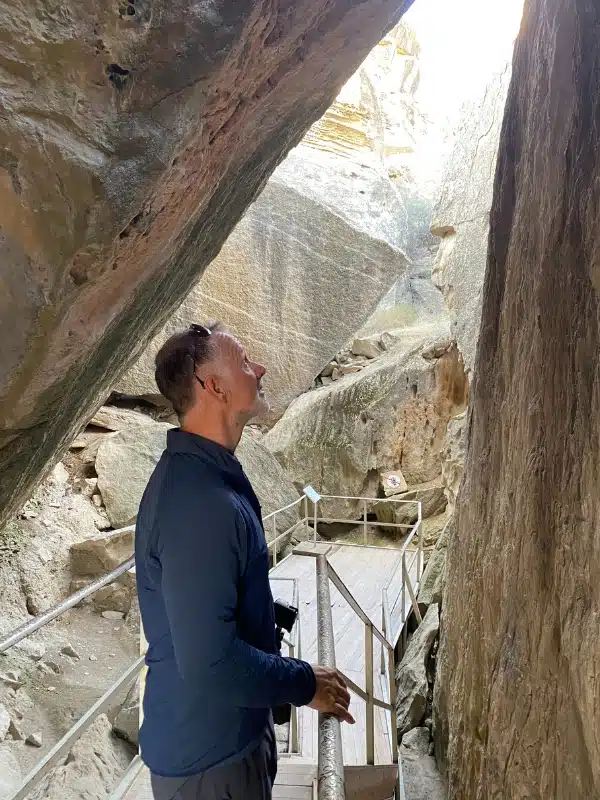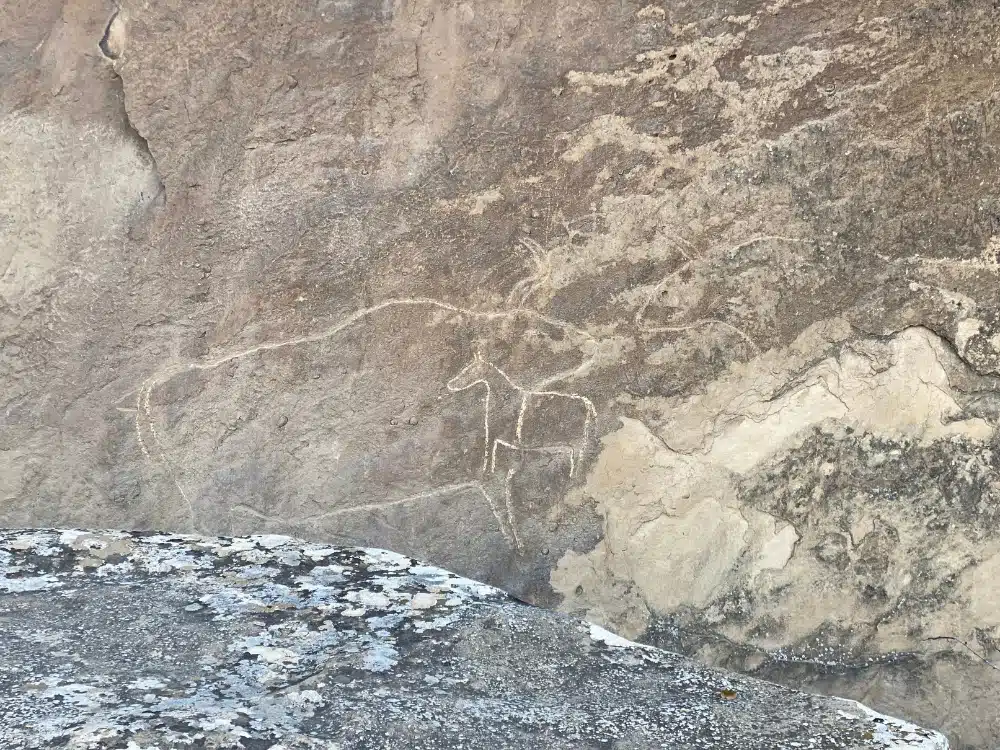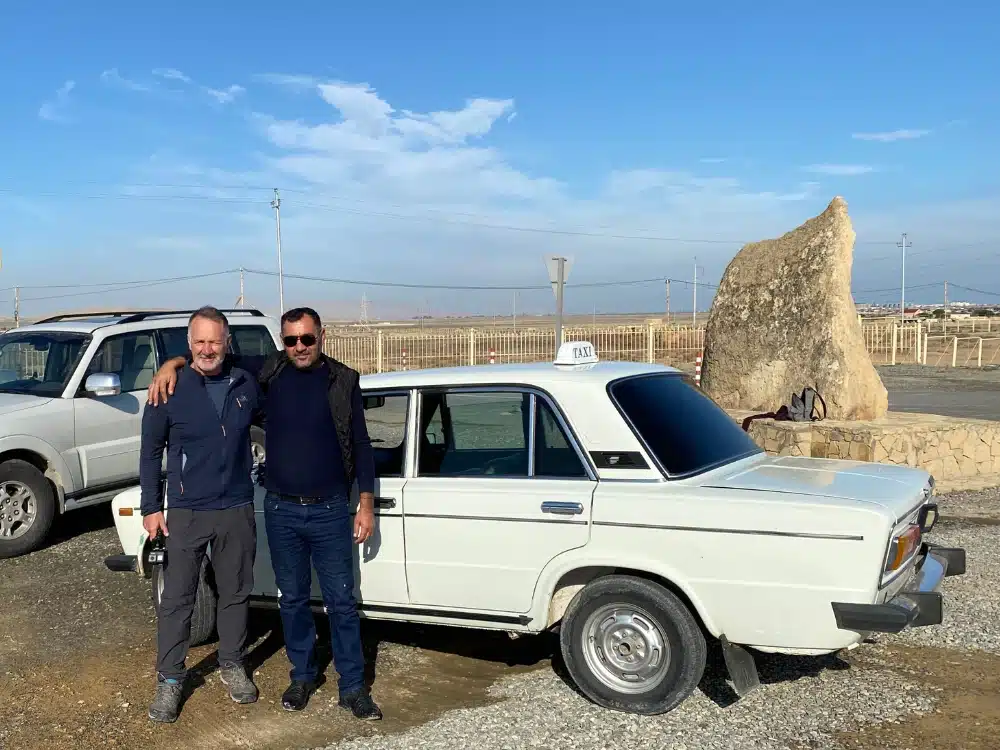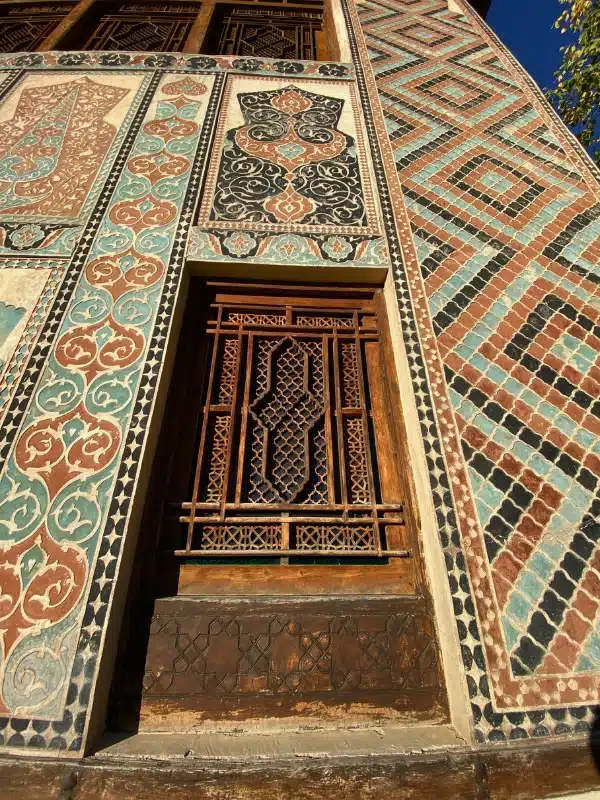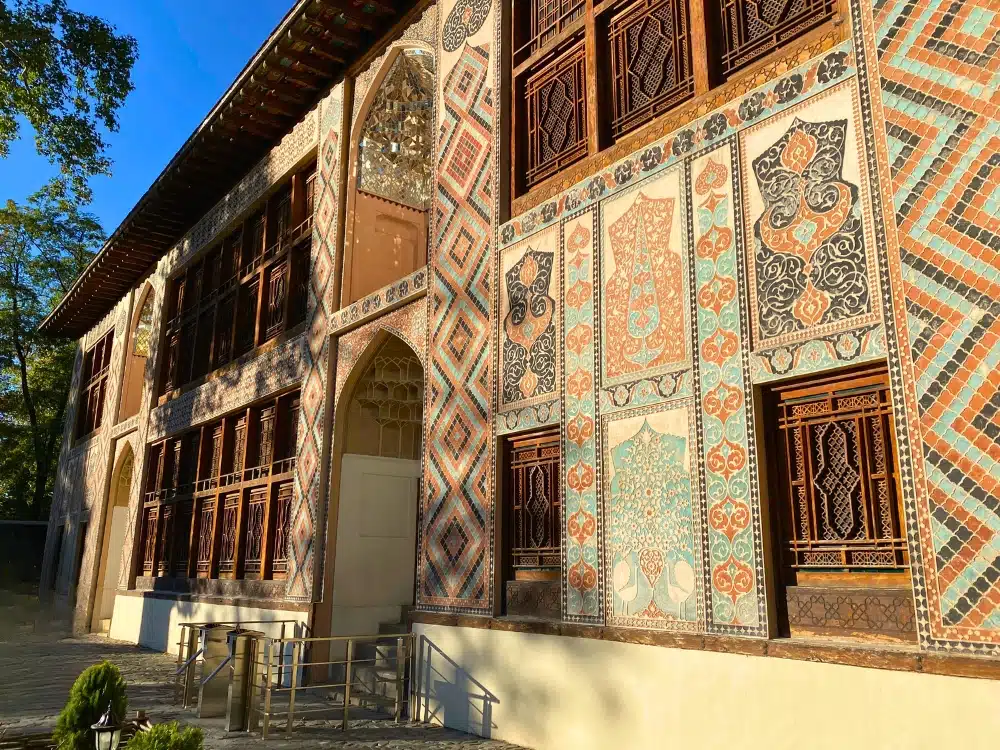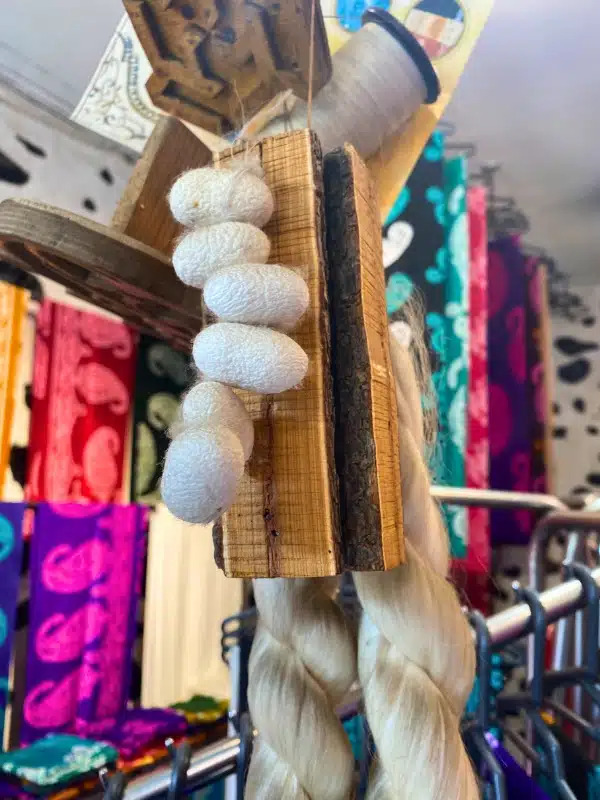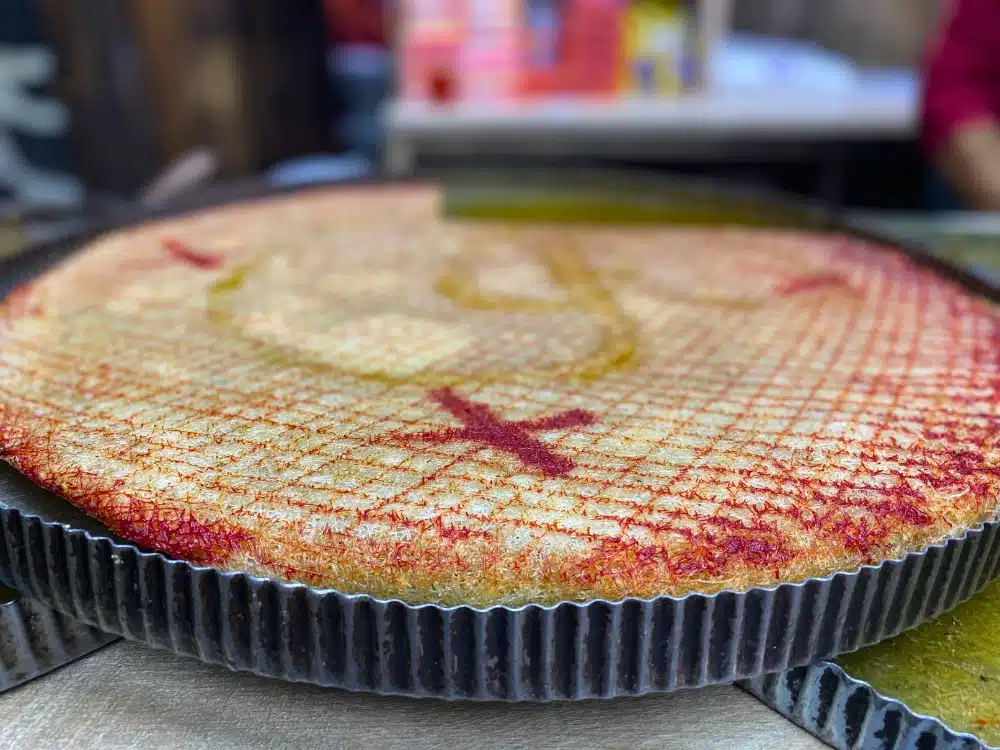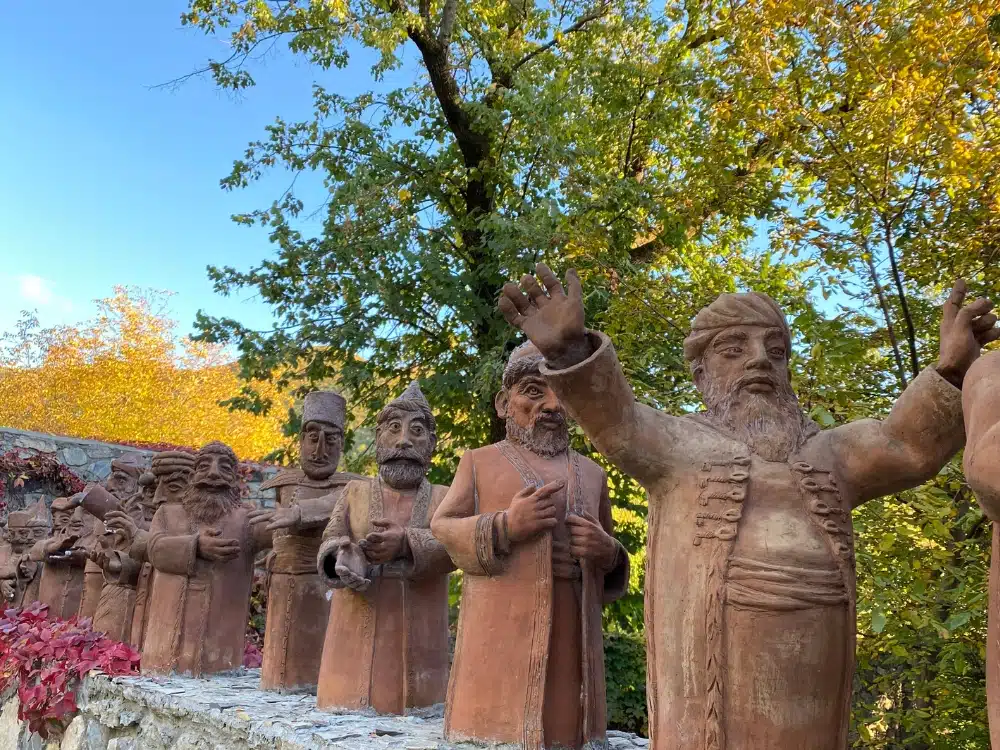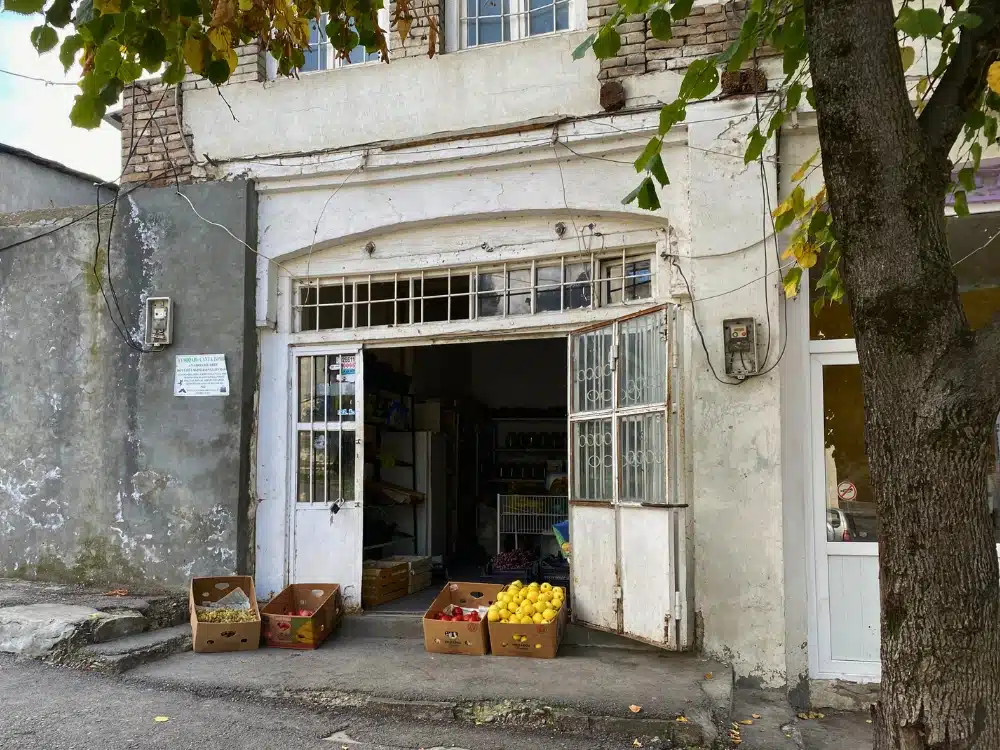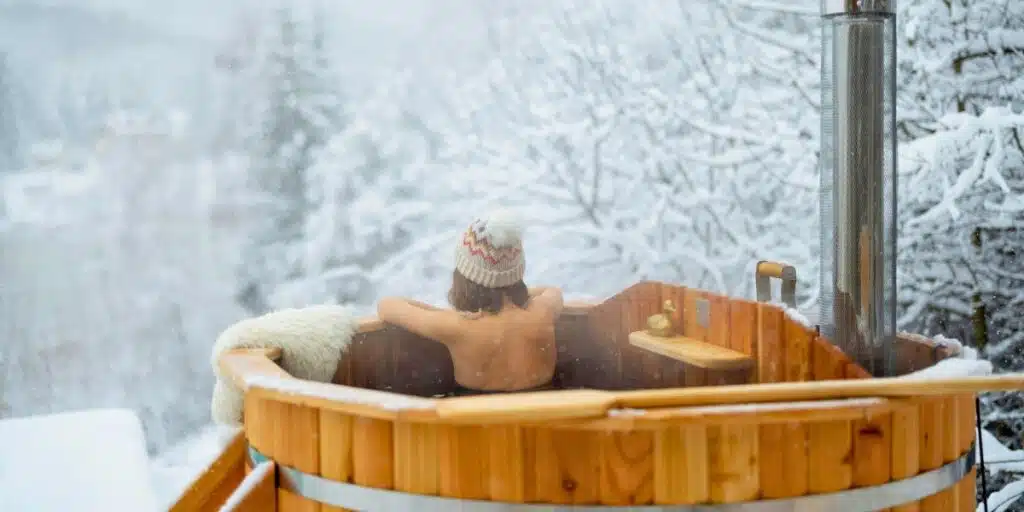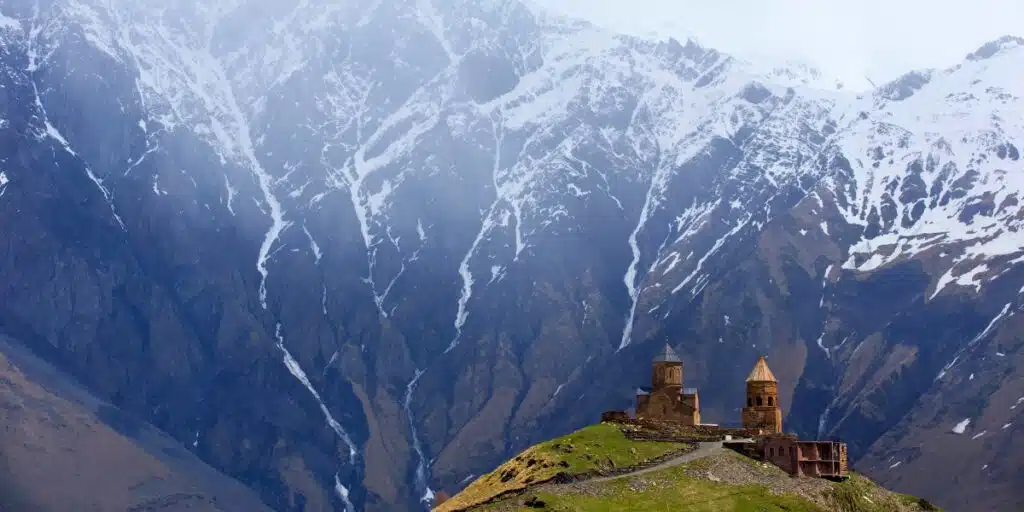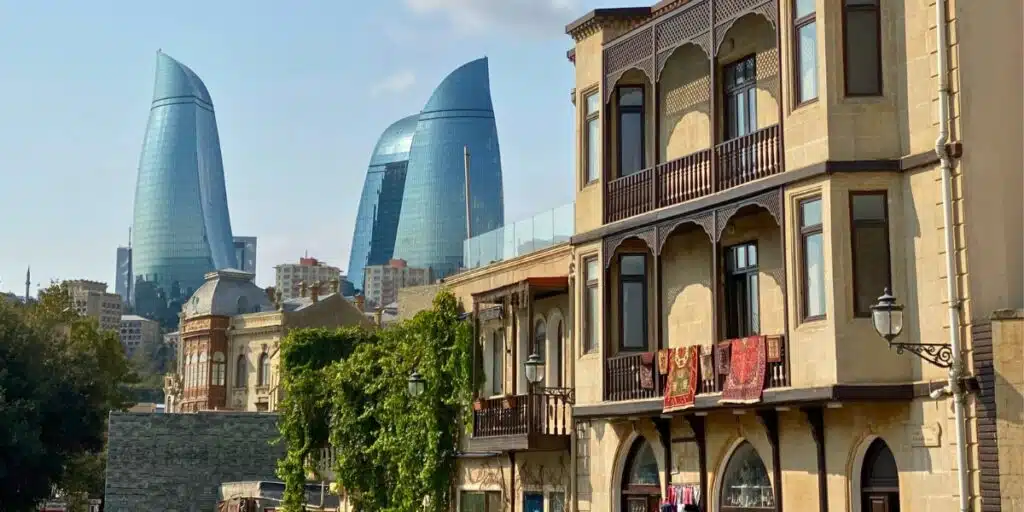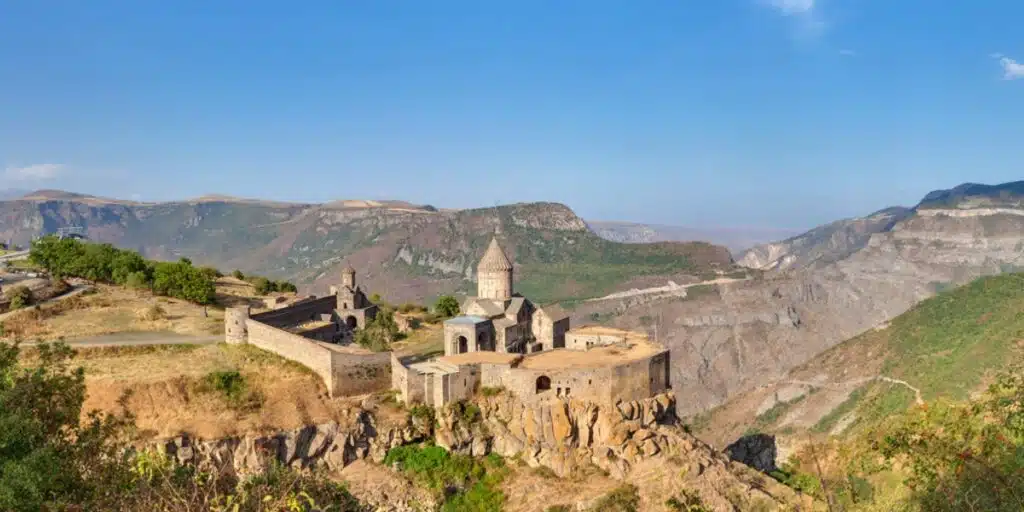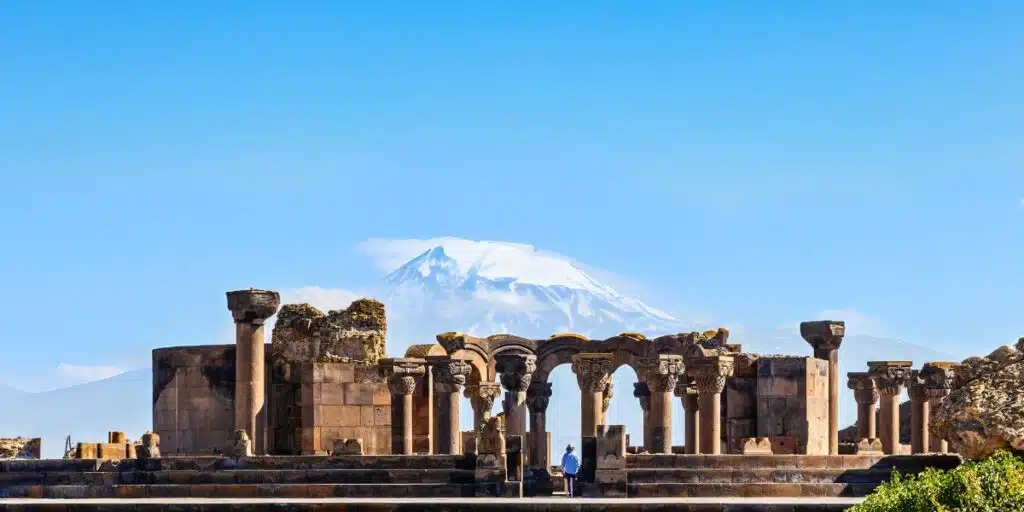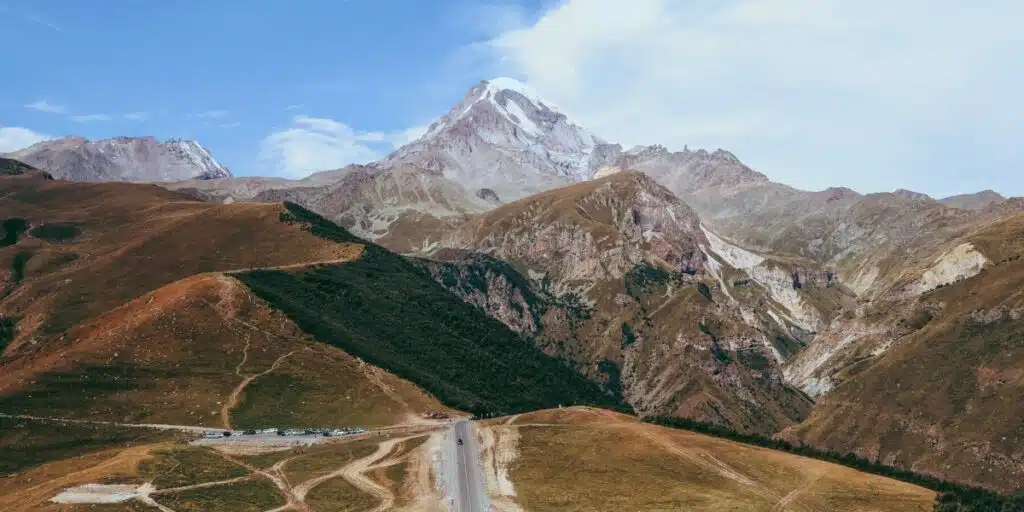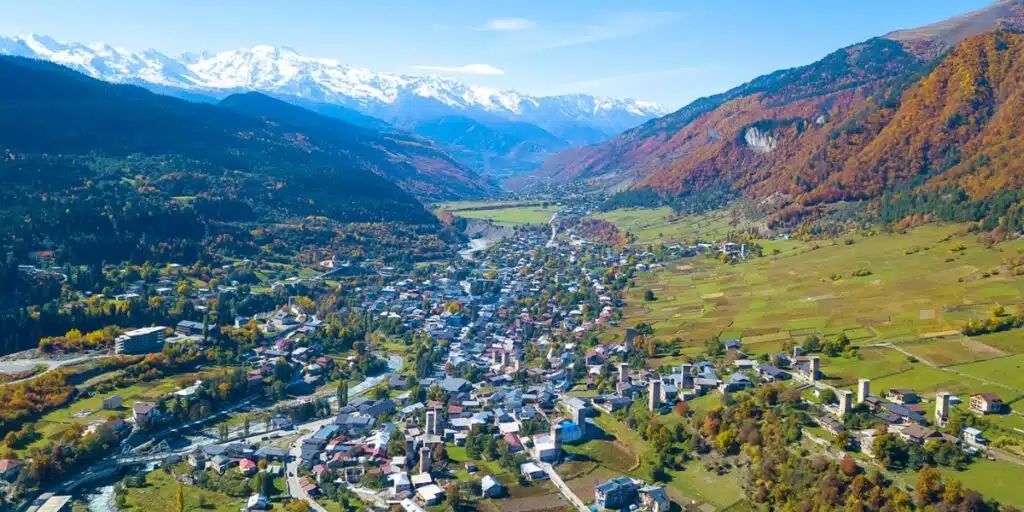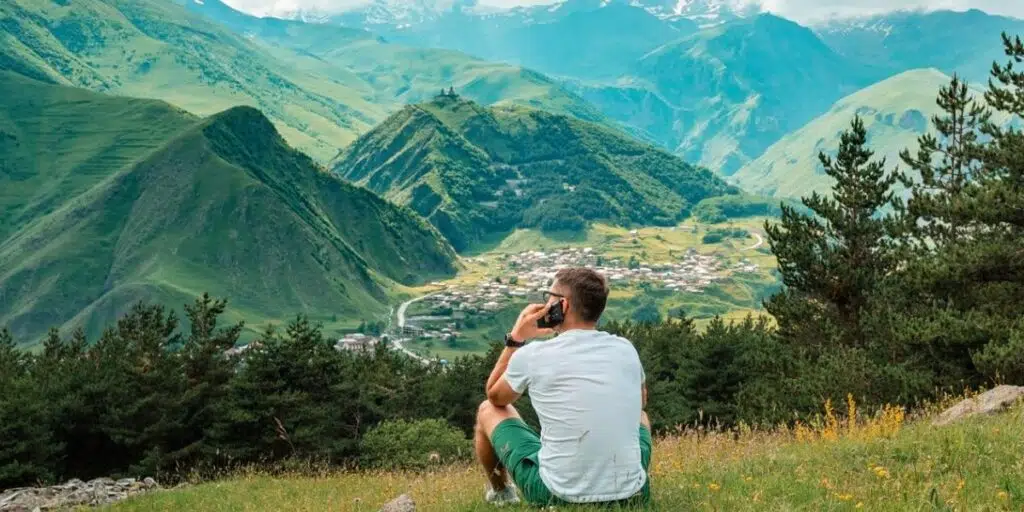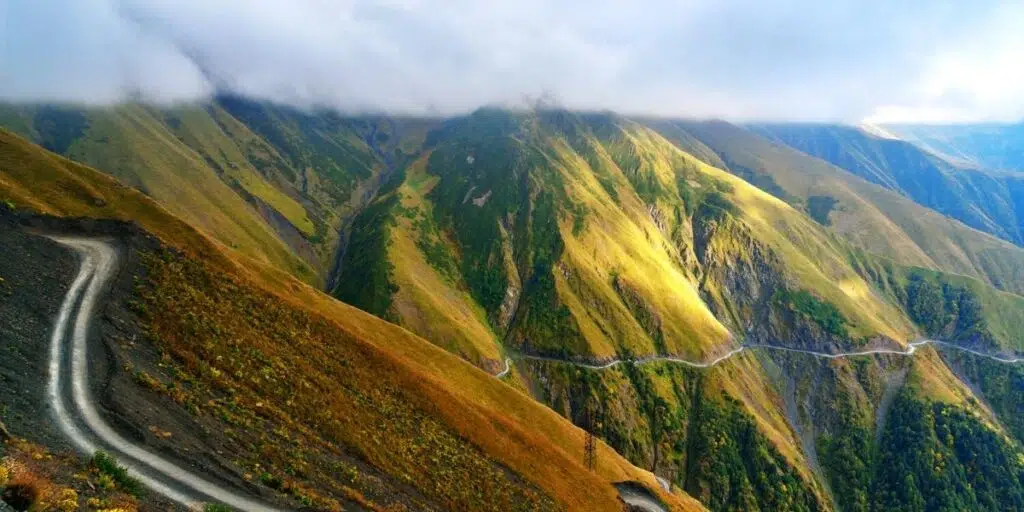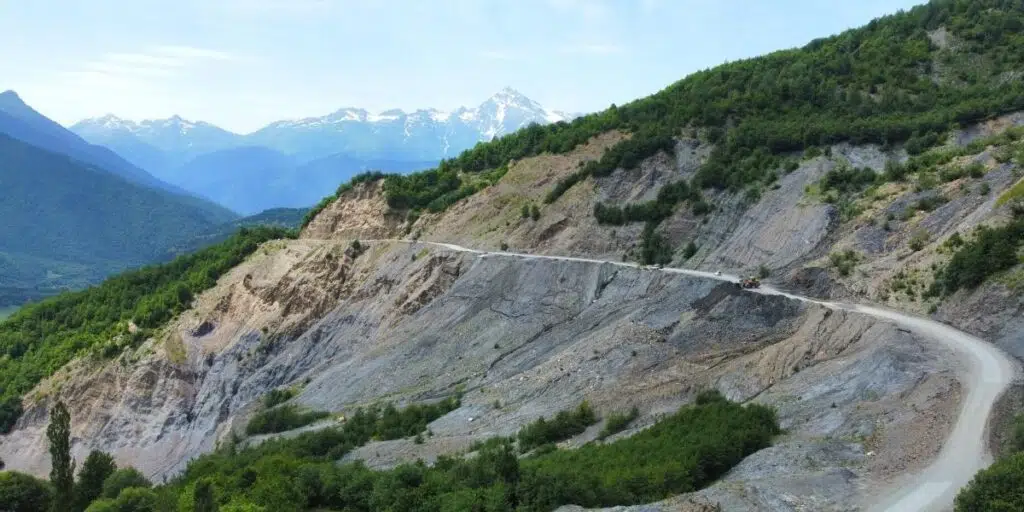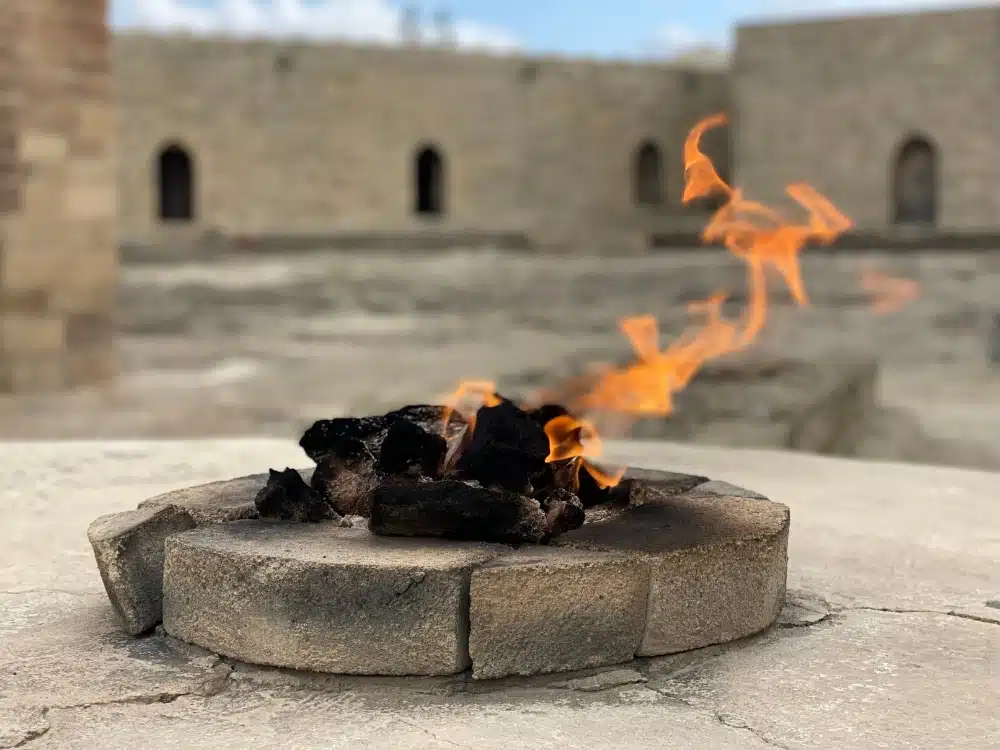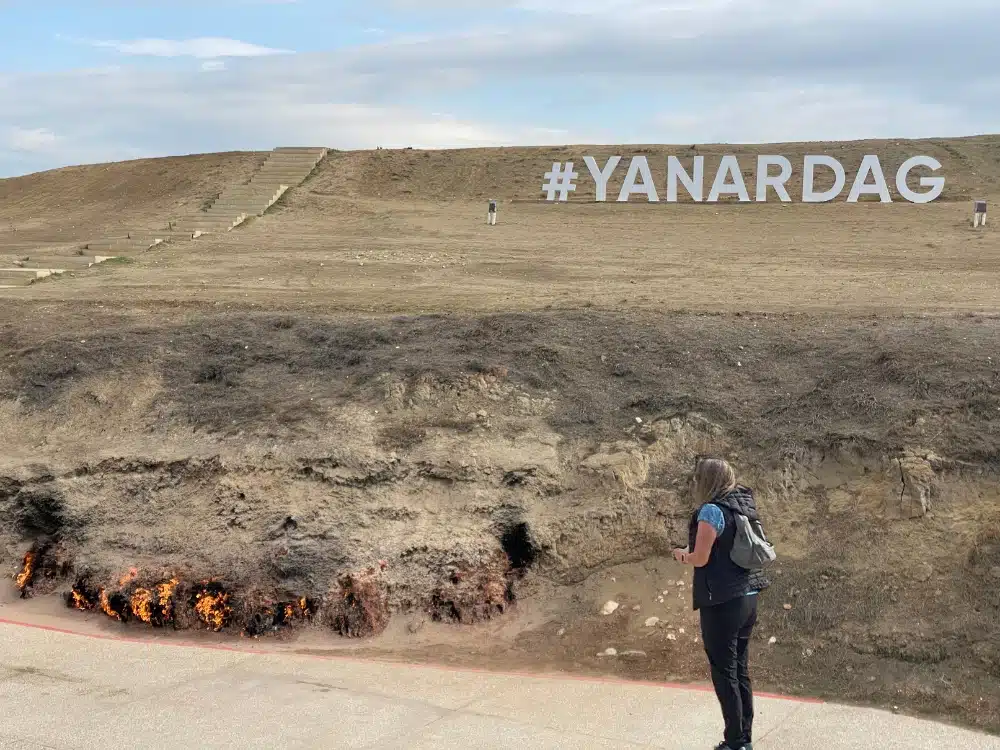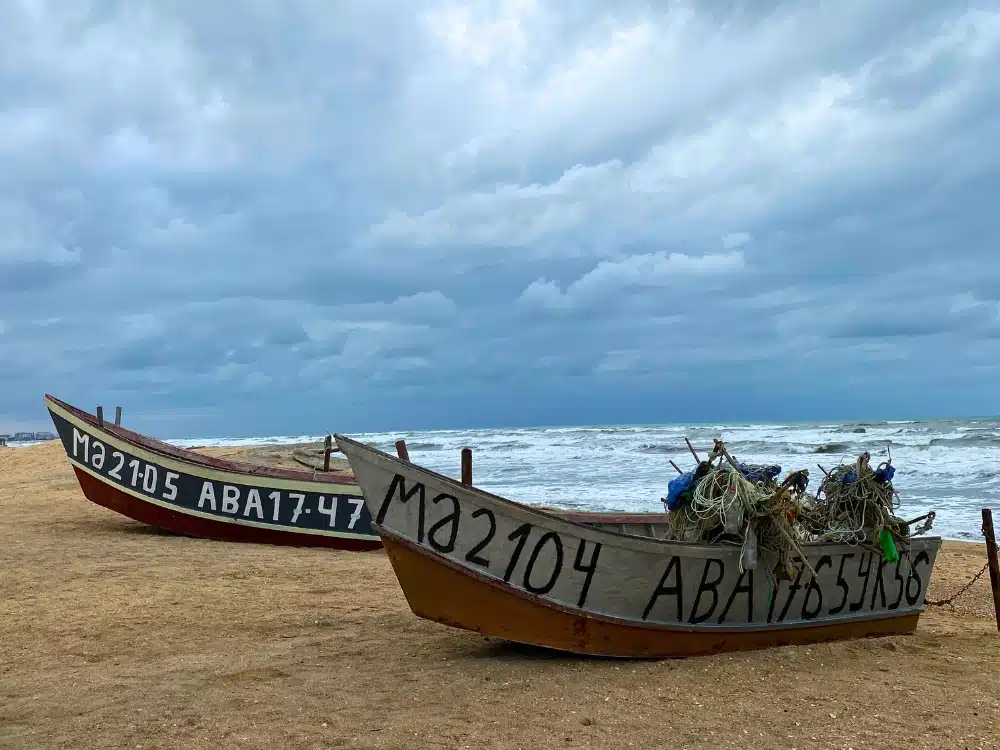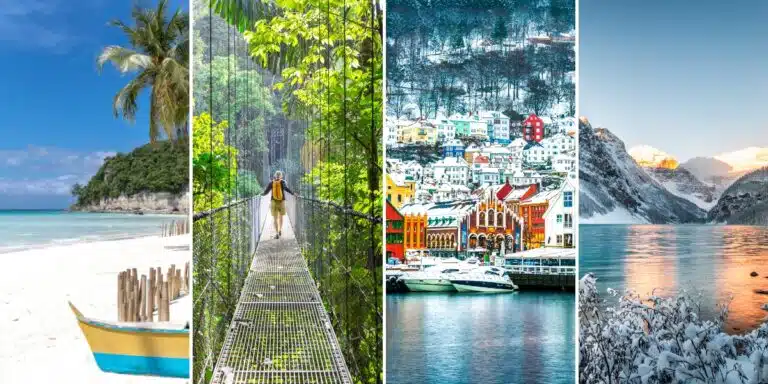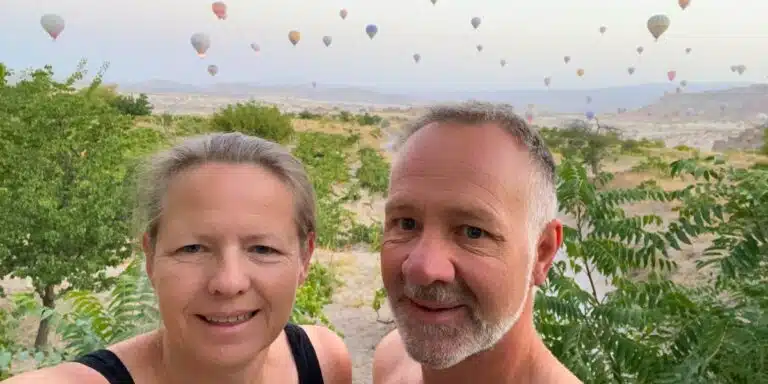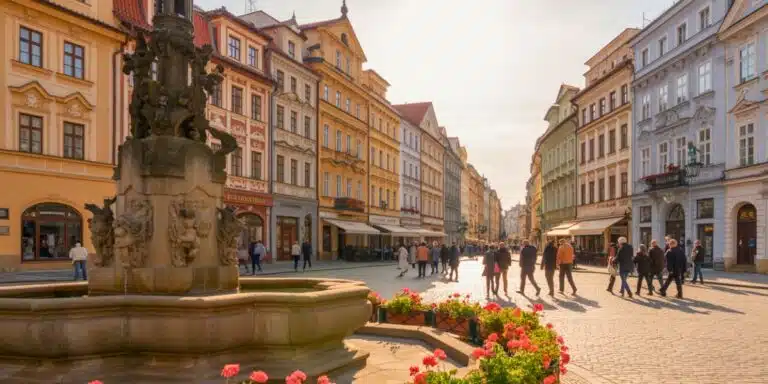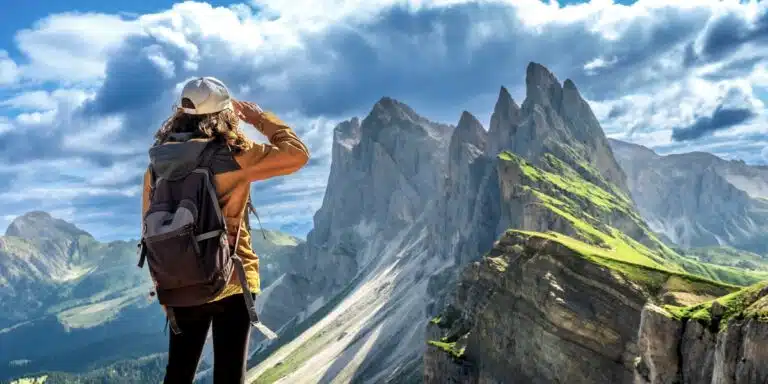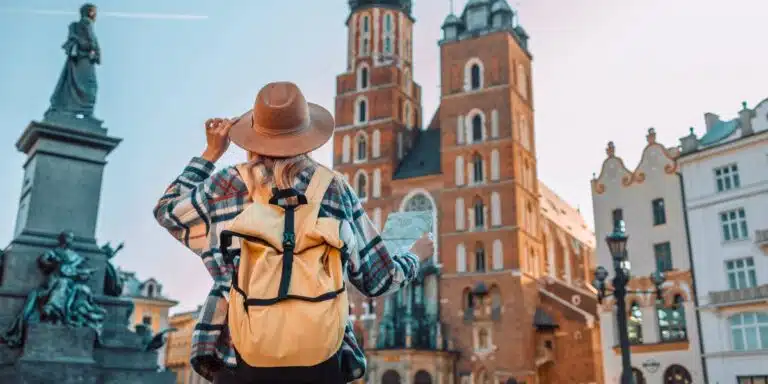This post may contain affiliate links, from which we earn an income. Click here to read our affiliate policy.
Discover Azerbaijan beyond Baku
Azerbaijan, the ‘Land of Fire,’ has long been a destination on our travel bucket list. Having spent several months in neighboring Georgia and Armenia, we were keen to explore the third country of the Caucasus region. While the glitzy capital city of Baku is undoubtedly a highlight, we knew there was so much more to discover beyond the city limits.
After immersing ourselves in the history, architecture, and vibrant energy of Baku, we decided to embark on a road trip to uncover the wild and rugged beauty of the rest of Azerbaijan. From the remote mountain villages to the mud volcanoes and ancient petroglyphs, our journey through this diverse country was nothing short of extraordinary.
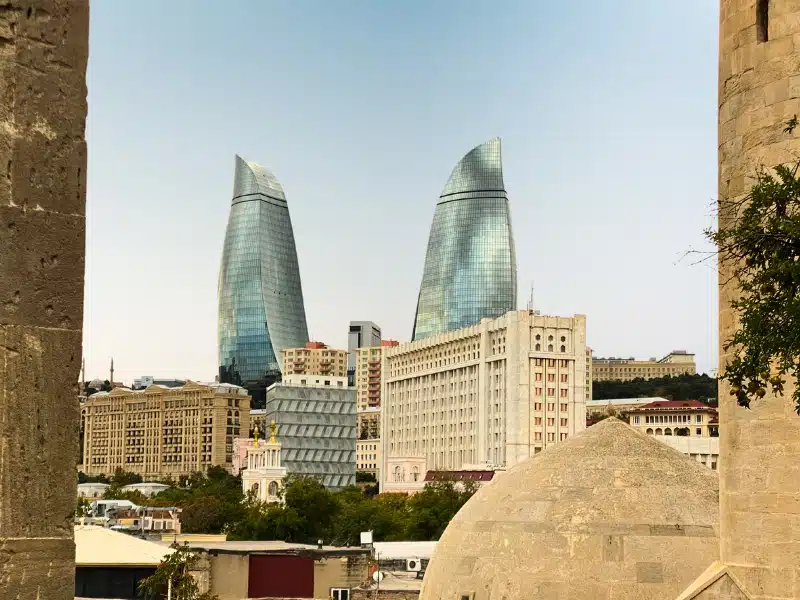
Discover the Contrasts of Baku
Both ancient and contemporary, Baku is the largest city in the Caucasus region and has long been a gateway between the mysterious East and the prosperous West, playing a crucial role in the ancient Silk Road trade routes.
Once a desolate and foreign landscape, Baku has undergone a remarkable transformation, emerging as a vibrant and glitzy metropolis thanks to its oil and gas-rich landscape. The city is a fascinating tapestry of contrasts, where the remnants of its Soviet past coexist with modern, cutting-edge architecture and a thriving arts and cultural scene.
Must-sees in Baku include the UNESCO old town known as Icherisheher, with its narrow alleys, ancient buildings, the ancient 12th-century Maiden Tower, and the gorgeous Shirvanshah’s Palace.
Contrast this with modern Baku and its symbolic Flame Towers that reflect Azerbaijan’s historical connection to fire, the Azerbaijan Carpet Museum, shaped and styled like a carpet like no other building on Earth, and of course, the iconic Heydar Aliyev Center, designed by the renowned architect Zaha Hadid.
Where to Stay in Baku
Our stay was one of two halves, just like the country! We spent five nights staying at the Home Boutique Hotel in the Yasamal district, a 10-minute walk from the old town. The room was beautifully clean and comfortable, the staff attentive and helpful, and the traditional breakfast was delicious. This hotel offers seriously good value for money.
After our road trip around the country, we chose the splurge option and treated ourselves to two nights at The Merchant, one of Baku’s premier hotels, with a price tag to match. Right in the city center, everything about this hotel is just gorgeous. From the interior design, the bed quality, and the food offering, it’s hard to find fault. This is a great option if you’re celebrating a special occasion in Baku.
RELATED POST: Things to Do in Baku: Explore the City of Winds
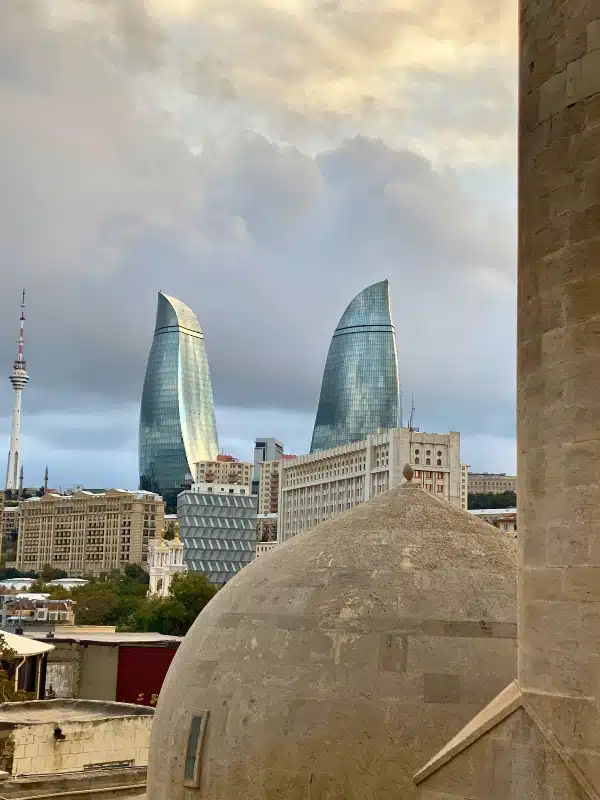
Venture North to the Remote Village of Khinaliq
Our first stop after leaving Baku was the northernmost village of Khinaliq (also called Xinaliq or Khinalig) high in the Greater Caucasus mountains. When you leave the main highway at Quba, the drive is full of winding roads, high canyons, switchbacks, and breathtaking vistas around every turn.
Khinaliq, thought to be over 5,000 years old, is situated at an elevation of 2,180 meters and claims to be the highest village in Europe… maybe! We also visited Ushguli in Georgia during our Caucasus trip, and they claim the exact same thing!
Until 2006, Khinaliq was completely cut off from the outside world during the winter months, accessible only by foot or donkey. Today, an epic road connects the village to the rest of the country but it still maintains a sense of isolation and timelessness.
In 2023, the cultural landscape of Khinalig, its nomadic people, and the 200-kilometer-long seasonal Köç Yolu transhumance route became the Caucasus’s 11th UNESCO World Heritage Site. The listing relates to the semi-nomadic tradition of families and their livestock moving between the lowlands and high mountains every spring and autumn.
The village is starting to open up to tourists but you won’t find any cute cafés or even an official place to park. The streets are unpaved with chickens and animals roaming freely, and the locals go about their daily lives. But the mountain scenery is stunning, with snow-capped peaks and rolling clouds that seem to envelop the village.
Things to Do in Khinaliq
Outdoor activities like horse riding and hiking are the main things to do in Khinaliq. Several trails start from the village, including the migration route and a stage of the Transcaucasian Trail.
Where to Stay in Khinaliq
It is possible to stay in a village guest house, where you will receive traditional and warm hospitality and immerse yourself in the local culture and way of life.
Getting to Khinaliq
There are three ways to get to Khinaliq. You can either hire a car and drive yourself, take a bus from Baku, or book a guided tour from Baku.
Self-Drive
We drove all over Azerbaijan for several weeks, and the drive to Khinaliq was by far the most spectacular. The road is generally good, and there are lots of spots to stop and enjoy the far-reaching views. We recommend you hire your car from Local Rent for the best deals and service.
We wouldn’t recommend driving to Khinaliq and back from Baku in a day. Although Google Maps says the drive is 3.5 hours, it’s way longer than that due to the road conditions and topography. We suggest staying overnight in Khinaliq or the nearest town of Quba, from which it’s a good two-hour drive.
If you decide to stay in Quba, it’s worth seeing the Red Village, an all-Jewish settlement with strong links to Russia and Israel, and visiting the Qadim Quba carpet workshop.
Bus
When traveling from Baku to Khinaliq using public transport, you must change at Quba. Minibuses to Quba depart regularly from the Baku International Bus Terminal.
From Quba, you will need to take a private car or shared taxi to Khinaliq. Taxis wait near the Central Bus Station in Quba, and you can negotiate the price with the driver depending on whether you’re stopping overnight or returning the same day. If you have booked a room in Khinaliq, the owner will be able to help you organize transport.
Day Trip
There are several full-day trips from Baku, which take in Quba, Khinaliq, and the red and white striped Candy Cane Mountains. These are our top picks:
Discover the Otherworldly Mud Volcanoes of Gobustan
From Khinaliq, we headed south to the Gobustan National Park, another UNESCO site and home to one of the most unique natural wonders in Azerbaijan – the mud volcanoes.
Azerbaijan is known for having the most mud volcanoes of any country in the world, with approximately 365 of the 700 mud volcanoes in the country located within Gobustan, sometimes called Qobustan. These otherworldly formations are the result of gas and mud being released from deep within the Earth’s crust, creating a constantly evolving landscape that resembles something straight out of a science fiction movie.
While the mud volcanoes may appear hostile at first glance, they are very much alive and ever-changing, with NASA geologists even drawing comparisons to the surface of Mars.
Some people go to the mud volcanoes and actually get in them, as the mud is considered to be good for the skin. I did put some on my face and was surprised to find it very soft but cold—for some reason, I expected the liquid mud to be warm. Don’t wear your best shoes, and take wet wipes if you want to play at mud pies!
Gobustan is also home to the Gobustan Rock Art Cultural Landscape, where more than 6,000 petroglyphs on more than 1,000 surfaces of rock reflect 40,000 years of rock art history. There is also an on-site museum to learn more about the geological and cultural significance of this unique natural wonder.
Getting to the Mud Volcanoes
The mud volcanoes that existed in the national park have dried up, and the nearest ones are a 20-minute drive away. You can find them on Google Maps and drive yourself (but you’ll probably want a 4×4, especially if it’s been raining), or you can get a taxi at the entrance to the park, which can take you to the mud volcanoes before or after you’ve visited the petroglyphs. Both things are equally worth doing.
We did have an odd experience at Gobustan, which neatly demonstrates the nature of Azerbaijan’s policing. Most historic sites in the country are policed at the entrance, and we were asked why we wanted to enter. We said we wanted to see the petroglyphs and mud volcanoes and were told we would not be allowed into the national park until we had gone to the mud volcanoes in a taxi, which the policeman would arrange.
We agreed because we felt we had little choice and actually had a very entertaining, if a little hairy, taxi ride in an ancient Lada (definitely not a 4WD!). When we shared our story with the receptionist at the park entrance when we were allowed access, she was horrified but sort of accepted that this was normal, too.
Later that evening, in our nearby guest house, the owner told us the police had not had a pay rise for 10 years and had openly said they would continue to supplement their meager salaries with corrupt practices until the government increased their pay. So we did our bit of Azeri law and order!
If you’re staying in Baku and want to get to Gobustan, the easiest way is to arrange a private taxi through your hotel or book this well-reviewed tour of the Gobustan rock arts and mud volcanoes.
Make sure you have travel insurance you can trust when visiting Azerbaijan. We recommend True Traveller for their 5-star TrustPilot reviews, variety of cover options, best activities cover as standard, great prices, and excellent service.
Shopping in the Craft Village of Lahij
Leaving the mud volcanoes behind, we headed north to the small village of Lahij (or Lahich if you’re using Google Maps) known for its rich history of craftsmanship and traditional trades.
Lahij is one of the most ancient human settlements in Azerbaijan, and it has long been recognized as the home of skilled artisans within the country. From metalworkers and carpenters to tanners, jewelers, and traditional hat makers, the village is a hub of traditional Azerbaijani craftsmanship that thrived during the Silk Road era.
The cobbled streets are lined with workshops and studios showcasing the local artisans at work, and they’re happy for you to stop and chat or take pictures (for a small fee). We liked the fact that we didn’t feel pressured to buy here, in contrast to browsing the artisan shops in Baku.
Along with the artisan shops are small cafés and restaurants where you can enjoy a traditional Azerbaijani lunch, such as the delicious qutab, a freshly cooked pancake filled with herbs and meat.
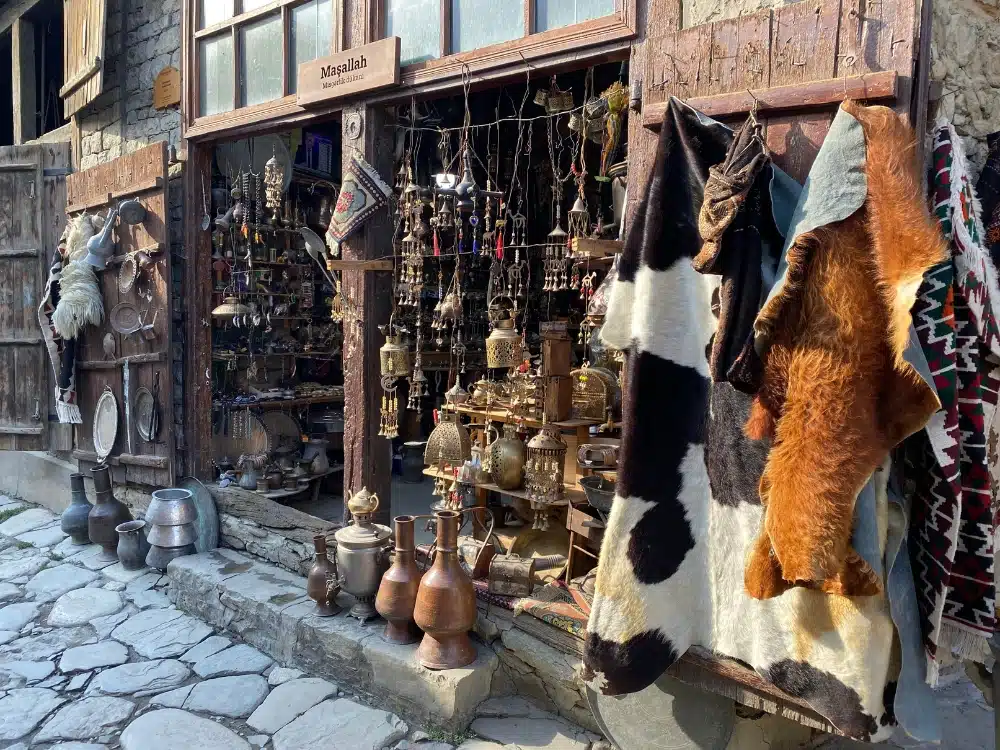
Exploring the Historic City of Sheki and the Silk Road Legacy
As we continued our journey northward, we arrived in the city of Sheki, which played a significant role in the Silk Road trade routes that once connected Asia and Europe.
Sheki is a town of two halves: the new part, where you’ll find modern hotels and restaurants, and the old town, with its traditional houses and cobbled streets that lead to the citadel, where you’ll find the Palace of Shaki Khans.
Shaki Khans Legacy
The impressive Shaki Khans’ Palace, a UNESCO World Heritage Site, served as the winter residence for the ruling Sheki Khanate in the 18th century. The palace is a stunning example of Azerbaijani architecture, with intricate frescoes, stained glass, and detailed tilework that showcase the region’s rich cultural heritage.
You can only see the inside of the palace with a guided tour, and photography or video recording is not allowed. Tickets can be bought on the day.
Also inside the citadel is a stained glass makers workshop where you can see how the unique Shabaka wooden frames that hold the stained glass in the palace windows were made without using nails or glue. There is also the
Museum Of History, Ethnography, And Local Lore, a very photographic temple, and a local craft market.
Deep in the old town is the Shakikhanovs’ Palace, the summer residence of the Shaki Khans. More in the standard vernacular of homes in the area than a palace, the craftsmanship and detailing in the interiors are breathtaking. We had the whole place to ourselves.
Ancient Church of Kish
The Church of Kish, also known as the Church of Saint Elishe, is a historic Christian church located in the village of Kish, near Sheki. The church is considered one of the oldest Christian sites in the Caucasus region and has significant cultural and historical importance.
Dating back to the early medieval period, the Church of Kish was originally built as an Albanian church, serving the local Christian community known as the Caucasian Albanians. These early Christians played a crucial role in the spread of Christianity in the region. The architecture of the church is characterized by a simple, basilica-style design, with thick stone walls and a domed roof, reflecting early Christian architectural influences.
The church, beautiful in its simplicity, and the surrounding village are well worth a visit, but you’ll need a car to get there. We would advise parking as you enter the village and walking up the hill on foot to the church.
UNESCO Silk Scarves
There is evidence of sericulture (silkworm breeding and silk production) in the region dating back to the 6th-century, and Sheki became a key hub on the trade routes linking Asia with Europe. This was due in part to Sheki’s location on the Silk Road but also because the white mulberry tree, whose leaves are the silkworm’s main food, thrives in the area.
The art of making kelaghayi (decorated silk headscarves) is included on the UNESCO Intangible Cultural Heritage of Humanity list. You can buy these beautifully fine scarves in town, and if you’re lucky, the shop owner may offer a tour of his family’s workshop. If not, find the now-defunct old silk factory and imagine what life might have been like back in the day.
Local Cuisine
The town’s most famous foods are Sheki halva, a traditional sweet made with layers of rice paper, chopped nuts, and spices like coriander seed and cardamom, a bit like baklava, and pit.
Piti is a dish cooked slowly in an earthenware pot with a lid. It consists of lamb, chickpeas, dried apricots, and saffron. The pot’s contents are rendered down until the fat is all gone, and you’re left with succulent meat in a delicious broth.
We were lucky enough to eat lunch with an Azeri family at Restoran Qaqarin, known for its pita. They shared with us the local way to eat pita: first, drain the broth from the pot and add broken bread to make a filling soup; next, tip the remaining meat, chickpeas, and apricots into the bowl for your main course.
Together with a traditional chobon salad of chopped tomatoes, cucumbers, peppers, onion, and parsley and a glass of local compote, water with infused fruits and sugar, piti makes for a very filling meal.
Where to Stay in Sheki
The Sheki Caravanserai (the Upper Caravanserai) between the citadel and the new town is a former resting place for Silk Road traders and their caravans. Now, some of those rooms have been converted to create the Karavansaray Hotel, a historic and atmospheric place to stay the night.
It is not possible to book a room online. You may be lucky outside of summer, but if you would like to have a room, you can call ahead at +994 557 555 570 or +994 557 125 717 to book a room. Some of the reception staff speak English, and you can use cash or a credit card to pay on arrival. If you prefer a more modern hotel, the Sheki Palace Hotel, just over the road, is very comfortable and has a good on-site restaurant.
If you prefer a day trip from Baku, book this recommended private Sheki day trip from Baku.
Other Caucasus Travel Ideas
Discover the Second City of Ganja
Well off the tourist path, Ganja is named after the medieval Persian poet Nizami Ganjavi, who was born there and is celebrated for his contributions to Persian literature.
Known for its beautiful architecture, including mosques, mausoleums, and public buildings, notable landmarks include the Nizami Mausoleum, dedicated to the poet, Javad Khan Street, which features traditional Azerbaijani architecture and the intricately tiled Imamzadeh Mausoleum, started in the 8th century.
Goygöl National Park
Not far from Ganja is the beautiful Goygöl National Park, home to Goygöl Lake, a freshwater lake at 1,500 meters above sea level in the Lesser Caucasus.
The lake, formed by an earthquake blocking the Ağsu River around 1,000 years ago, is known for its vibrant blue-green hues and the surrounding lush, forested landscapes. Activities like swimming are restricted to prevent pollution, maintain water quality, and protect the local ecosystem, which includes various species of plants and animals.
The climate around the lake is relatively cool, and the waters are notably clear and clean. This clarity, combined with the lake’s unique color, makes it a popular spot for photographers. Nature enthusiasts should keep an eye out for the diverse flora and fauna that call the national park home, including bears, leopards, lynx, and a variety of bird species.
Maralgöl Lake, also known as ‘Deer Lake,’ is another prominent lake in the national park, named after the deer commonly found in the surrounding areas. Maralgöl Lake is slightly smaller than Göygöl but is similarly beautiful, with a serene atmosphere and lush vegetation around it. Smaller lakes, such as Zəligöl, Ağgöl, and Qaragöl, vary in size and accessibility, often nestled deeper within the forested and mountainous areas of the park.
Ecotourism trails snake between the lakes and local beauty spots. More experienced hikers can follow the 20 km-long route to the top of Mount Kapaz, which rises to 3,065 meters above sea level.
Where to Stay in Ganja
We stayed at the Premium Hotel on the outskirts of the city. It was a little soulless but sparkling clean and very modern, and a five-minute taxi journey or 20-minute walk into the center.
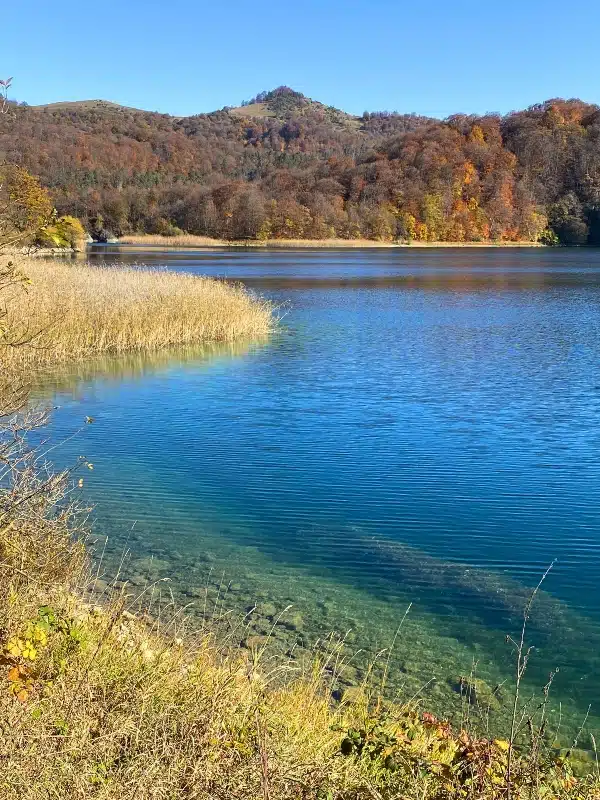
Exploring the Absheron Peninsula
We had a few days to spare, so we decided to take a mini road trip around the Absheron Peninsula close to Baku and see some of the places we missed while in the city.
It’s an odd place – not the city, but not the stunning countryside we had become accustomed to on our tour of the country. There are oil wells everywhere – next to the road, squeezed in between residential properties, and wherever there was a slither of space. The air itself smelled of oil.
Yanardag
Yanardag, which means ‘Burning Mountain’ in Azerbaijani, is a natural gas fire that continuously burns on a hillside. The phenomenon is fueled by natural gas seeping through the sandstone on the hillside, creating a seemingly eternal flame. The fire has been burning for at least a few hundred years, and possibly much longer, as the gas reserves beneath the surface provide a continuous fuel supply.
The site is a popular attraction and often touted as a must-see among the top three things to do in Azerbaijan. We found it quite underwhelming. The actual fire is maybe two meters long and burns quite low, with none of the leaping flames we were expecting. On the hill behind the fire, you can rent quad bikes and take a short walk, but that’s about it.
Ateshgah
The Ateshgah, also known as the Fire Temple of Baku, is a historic religious site whose name is derived from the Persian words atash (fire) and gah (place), translating to ‘place of fire.’ We found the temple way more interesting than Yanardag.
The temple, which dates back to the 17th and 18th centuries, was built by Zoroastrians, followers of an ancient religion that worshiped fire as a symbol of purity and divinity. The Ateshgah is constructed in a pentagonal shape with a central courtyard surrounded by a series of cells or rooms that once housed pilgrims and ascetics.
In the center of the courtyard stands an altar, where a natural gas flame, originally fed by underground gas deposits, would burn continuously, symbolizing the eternal flame of the Zoroastrian faith.
There are several half-day trips from Baku which visit both Yanar Dag and Ateshgah. These are our top picks:
The Caspian Sea
We tried very hard to get to the Caspian Sea, but our efforts proved to be almost fruitless, other than strolling Baku Boulevard. Most of the coast of the Absheron Peninsula is populated by private beach clubs, hotels that don’t want to share their access if you’re not a guest, docks, ports, or things to do with oil. In fact, there is a whole city of oil rigs built just off the shore called Neft Dasları.
The coastline felt a little sad and neglected (the October weather may not have helped), and when we asked at our hotel whether swimming in the sea was possible, we were met with disbelief that we would want to!
Practical Tips for Driving in Azerbaijan
Renting a car and embarking on a road trip is one of the best ways to discover the hidden gems of Azerbaijan beyond the capital city of Baku. However, there are a few things to keep in mind when driving in this fascinating country:
That’s a Wrap!
Our road trip through Azerbaijan was a true adventure, filled with breathtaking natural landscapes, rich cultural heritage, and a deep sense of exploration and discovery. While the glitz and glamour of Baku may be the initial draw for many, it’s the off-the-beaten-path destinations that truly showcase the essence of this fascinating country.
From the remote mountain villages to the otherworldly mud volcanoes and the historic Silk Road cities, Azerbaijan is a destination that offers something for every type of traveler. By venturing beyond the capital and immersing ourselves in the country’s diverse landscapes and traditions, we were able to uncover a side of Azerbaijan that is both captivating and humbling.
Looking for more destination ideas? Check out these top posts…
16 of the Best Travel Destinations in January
Our 60 Before 60 Travel Bucket List
The 16 Best Second Cities in Europe You Shouldn’t Miss
Adventure Travel Bucket List: 15 Epic Experiences in Europe
Travel Trends 2026: The Year of Mindful Escapes and Meaningful Journeys
The Ultimate Europe Travel Bucket List: 15 Classic Experiences to Inspire Your Next Trip
Love it? Pin it!
